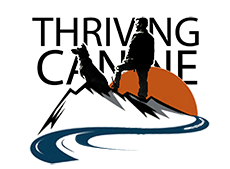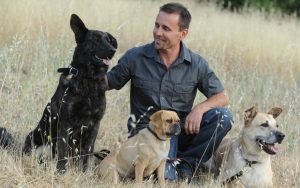 Halloween is almost as fun as Christmas for some folks. Decorating the house, dressing up in costumes, going to parties, passing out candy…fun stuff! It's the one time of year where we seek out 'the scary.' My wife and I have a tradition of watching scary movies during the entire month of October. We go to freaky corn mazes and haunted houses in search of that good scare. There's no question that these rituals are a little curious and strictly a human endevour. Animals must think we are so weird! Dogs are creatures that do not like to be frightened and would certainly not go out of their way to have the spooky experiences we pay money to have.
Halloween is almost as fun as Christmas for some folks. Decorating the house, dressing up in costumes, going to parties, passing out candy…fun stuff! It's the one time of year where we seek out 'the scary.' My wife and I have a tradition of watching scary movies during the entire month of October. We go to freaky corn mazes and haunted houses in search of that good scare. There's no question that these rituals are a little curious and strictly a human endevour. Animals must think we are so weird! Dogs are creatures that do not like to be frightened and would certainly not go out of their way to have the spooky experiences we pay money to have. In the dog's mind there is no such thing as a good scare, only bad ones. They don't know that those zombies banging on the front door are just the trick-or-treating kids from next door or that the creepy lawn decorations around the neighborhood are not really the dead rising from their graves. These decorations and zombie children can easily be perceived as truly dangerous or threatening which can cause a dog to panic or attack.
Even an otherwise well-socialized dog can have trouble interpreting these encounters with the undead so it's a good idea to be prepared before World War Z actually hits on Hallow's Eve. Here are a couple helpful tips:
- Use this ghostly season as a chance to socialize your dog more thoroughly. Don't wait until Halloween night to do this as that would be a set up for failure. Walk the neighborhood during the day and let your dog see the lawn decorations. If your dog is afraid of any of them just stop and stand in front of that house until your dog becomes desensitized to them. DO NOT try to sooth your dog and DO NOT force your dog towards the scary object. You can use the leash to interupt your dog from fleeing but otherwise just hang out and relax. This will give your dog the signal that these tombstones and giant pumpkin balloons are no big deal. Once your dog relaxes and is no longer in "fight or flight" mode, you may move on or allow your dog to investigate the object.
- Halloween socialization phase II would be to walk the same neighborhood at night. Try going out around sunset the first time so there is still some fading light. Follow the same instructions as above and move on to full blown night walks once your dogs seems comfortable.
Manage Trick-or-Treating
Trick-or-Treaters need to be kept safe from your dog and your dog from them. This is a time when you need to know your dog. If your dog is typically happy to greet strangers at the door this will be much easier than if you have a fearful or protective dog. If normal mortals are an issue then a never ending parade of gouls and gobblins may send Rover into overdrive. In extreme cases you will need to keep Rover away from the action completely. This may mean putting him in the back room of the house or whatever options you have that will be safe and the most isolated from the action. I also suggest giving him a treat he'll enjoy that will also keep him occupied such as a kong toy filled with treats or a bone that will keep him busy and happy for a while.
In milder cases you may want to give Rover some exposure to the action in a safe manner. Keeping him on a leash would be a definite minimum and maybe putting up a baby gate or ex-pen to keep the entry way a dog-free zone. Have one bowl of candy for the kids and another bowl for dog treats. Each time the kids get tricks-or-treats so does Rover, assuming he's well-behaved. Fun! This is what behaviorists call desinsitizing and counter-conditioning. If your dog knows any tricks, have him do some of his best for treats as well. If he is being very good you can have the kids toss him a treat. If he is doing okay but still apprehensive then don't push it, just let him observe from a distance.
The most important thing about Halloween is safety must come first. We don't want anyone to get bitten and we don't want a traumatized dog. If your dog is not well-socialized then Halloween night is not the time to start. You need to start smaller and build up as appropriate. Use common sense and if your dog has behavior issues, especially fear or aggression, please get some professional help in your area.
Otherwise, just be prepared, be safe and have fun!
Happy Haunting,
Chad Culp, Certified Dog Trainer and Canine Behavior Consultant (Muwah, ah, ah, ah!)
© Thriving Canine 2013
Related Topics:
Fear and Fireworks: Is it Ok to Comfort a Fearful Dog?
Hosting the Holidays with Fido
Top 10 New Year's Resolutions: How To Incorporate Your Dog
Stay Connected:
Check out www.ThrivingCanine.com for more free articles, videos and sign up for the Weekly Newsletter.
Subscribe to Thriving Canine YouTube Channel
Apply for membership of the THRIVING CANINE UNIVERSITY Facebook group. (please read the rules before joining)



